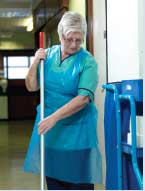Safe and Well at Work: Occupational Health and Safety Strategic Framework for NHSScotland
This person centred strategic framework sets out how NHSScotland Boards should approach occupational health and safety to keep staff motivated and healthy, engaged and safe. It provides a national statement of aims and priorities, together with a clear framework for delivering improvements in the occupational health and safety of NHSScotland staff.
Chapter 3: Occupational Health and Safety Performance
The three quality ambitions - person-centred, effective and safe - are at the heart of this strategic framework.
3.1 Person-centred
The Quality Strategy sets out an ambition for NHSScotland to ensure mutually beneficial partnerships between patients, their families and those delivering healthcare services which respect individual needs and values and which demonstrate compassion, continuity, clear communication and shared decision making. |
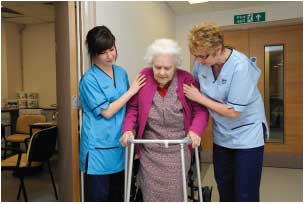 3.1.1. NHSScotland Boards must promote and support staff engagement and partnership working. Effective partnership working arrangements and implementation of the Staff Governance Standard will ensure shared decision making in relation to the provision of an improved and safe working environment where staff are appropriately trained to carry out their roles. This should focus specifically on ensuring that all staff, including occupational health and safety staff, are appropriately trained and educated. They should also make use of their local structures, including local health and safety committees, with trade union health and safety representatives having a key contribution to make. The wider benefit from this approach will be the reduction in accidents and incidents for staff, patients and visitors.
3.1.1. NHSScotland Boards must promote and support staff engagement and partnership working. Effective partnership working arrangements and implementation of the Staff Governance Standard will ensure shared decision making in relation to the provision of an improved and safe working environment where staff are appropriately trained to carry out their roles. This should focus specifically on ensuring that all staff, including occupational health and safety staff, are appropriately trained and educated. They should also make use of their local structures, including local health and safety committees, with trade union health and safety representatives having a key contribution to make. The wider benefit from this approach will be the reduction in accidents and incidents for staff, patients and visitors.
3.1.2. All staff across NHSScotland must have equal access to comprehensive, competent, confidential and quality occupational health and safety advice services. NHSScotland Boards should be proactive in informing and supporting staff to manage and maintain their health, and to manage ill health in a constructive manner. Staff, in turn, need to take responsibility for their own health, safety and wellbeing. This includes employee duties under Section 7 of the Health and Safety at Work Act 7 and Regulation 14 of the Management of Health and Safety at Work Regulations 8. NHSScotland Boards are expected to develop a unique local approach encompassing in full the requirements of effective health and safety management, and extending this to encompass the focus on early intervention health promotion and wellbeing, along with resilience and mental health support (e.g. through the Working Well Programme and Healthy Working Lives Awards). It should also include the establishment and development of more robust attendance management systems and processes complemented by targeted communication and promotion.
3.1.3. Employee experience must be supported and improved through effective employment and working practices, e.g. by delivery of Partnership Information Network ( PIN) policies and implementation of action in relation to the staff survey findings.
Summary and actions:
- NHSScotland Boards must promote and support staff engagement and partnership working, making use of local structures, including local health and safety committees.
- NHSScotland Boards must focus on ensuring all staff, including occupational health and safety staff, are appropriately trained and educated.
- All staff across NHSScotland must have equal access to comprehensive, competent, confidential and quality occupational health and safety advice services.
- NHSScotland Boards should be proactive in informing and supporting staff to manage and maintain their health, and to manage ill health in a constructive manner.
- Staff need to take responsibility for their own health, safety and wellbeing. This includes employee duties under Section 7 of the Health and Safety at Work Act and Regulation 14 of the Management of Health and Safety at Work Regulations.
- NHSScotland Boards are expected to develop a unique local approach encompassing in full the requirements of effective health and safety management, and extending this to encompass the focus on health promotion and wellbeing, along with resilience and mental health support.
- Employee experience must be supported and improved through effective employment and working practices.
3.2 Effective
NHSScotland's ambition is to ensure the most appropriate treatments, interventions, support and services will be provided at the right time to everyone who will benefit, and wasteful or harmful variation will be eradicated. |
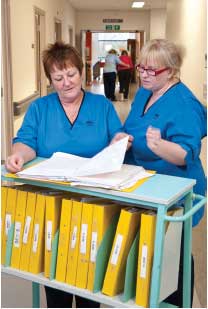 3.2.1. Clinical governance within NHSScotland requires all Boards to take responsibility for ensuring the quality, safety and effectiveness of the services they provide. Progress is monitored through a set of national standards. However, for Boards to achieve these standards, they need to have a workforce that can effectively deliver the quality of clinical care required.
3.2.1. Clinical governance within NHSScotland requires all Boards to take responsibility for ensuring the quality, safety and effectiveness of the services they provide. Progress is monitored through a set of national standards. However, for Boards to achieve these standards, they need to have a workforce that can effectively deliver the quality of clinical care required.
3.2.2. The first stage in ensuring an effective workforce is for NHSScotland Boards to assure themselves as employers that they are meeting all statutory standards and health and safety regulations as a matter of course. However, standards of performance should go beyond statutory duties and Boards are expected to enhance the standard of provision through risk assessment and a process of continuous quality assurance and improvement.
3.2.3. The next stage is to focus on prevention, supporting staff to avoid illness or injury and, where events do occur, working to retain individuals in the workplace.
3.2.4. The Health and Safety Executive statistics recently reported that "In 2009/10 an estimated 1.3 million people who had worked in the last 12 months, and a further 0.8 million former workers, suffered from ill health which they thought was work related." 9 The same report notes that musculoskeletal disorders (572,000) and stress (435,000) were the most commonly reported illness types. We also know from HSE statistics that the 'health and social work' and 'public administration and defence' employment sectors had prevalence rates of work-related illness statistically significantly higher than average.
3.2.5. A priority area for action will therefore be musculoskeletal disorders as this workforce health issue causes significant sickness absence across NHSScotland.
Staff Story Client A female nurse in a busy orthopaedic trauma unit self referred to the occupational health physiotherapy service because of back and leg pain which had come on during a 12½ hour shift. There was no history of any specific accident/injury though the shift had been very busy with patient handling activities. At the time, the nurse felt this problem was not severe enough to require a GP appointment. However, the pain increased significantly over the following two days when she was off, leading to absence from work. She phoned the occupational health physiotherapy service at the hospital and referred herself. She was given immediate self-management advice over the telephone and was e-mailed further information. She was also given an appointment to attend for treatment the following day. Outcomes Although the nurse required to be off work for a short period, the speedy advice, assessment and treatment she received from the occupational health physiotherapy service allowed her to get back to work in a timely and safe manner. The specialist service provided advice about modified duties and hours of work in keeping with her stage of recovery. A return to work programme also assisted in her functional rehabilitation and enabled her to continue to actively engage at work which was something she had been worried about. She found the service to be very beneficial as it helped her get back to work more quickly than she would otherwise have been able to. It also allowed her quick access to support at a location that was convenient to her workplace. She felt the workplace input was invaluable for her and also supported other staff in her workplace. |
3.2.6. A second priority for action is promoting a mentally healthy workplace. The NHSScotland approach must be to adopt policies and approaches that are proactive and are aimed at minimising activity that leads to workplace stress and ill health (through, for example, strong management practices and effectively managed change processes). It also includes working with people who are facing stresses and strains elsewhere in their lives to help support them in the workplace. Towards a Mentally Flourishing Scotland10 outlines the proposed future direction for mental health improvement and population mental health in Scotland.
Staff Story Client A woman working in housekeeping services was reported to be a good worker who was frequently moved from place to place to cover different areas. She was absent from work, and reported feeling stressed, overloaded and was experiencing difficulties coping at work. She presented with anger issues and issues with her mood which were impacting on relationships at work and home. Assessment and services provided The woman was initially seen for a psychological assessment to ensure appropriateness of service. She was then offered a series of appointments for therapy and attended six in total. The assessment highlighted that she was suffering with post-traumatic stress disorder ( PTSD) relating to previous events in her personal life; there was an unresolved significant bereavement and significant difficulties with assertiveness. The therapy focused on the unresolved grief, the assertiveness difficulties and worked through the traumas which led to the PTSD. Outcomes The woman returned to work on discharge from the staff psychology service. She was able to assert herself to address the work issues which were contributing to her feeling overwhelmed. Her grief was resolved as were the symptoms of PTSD. Her mood was also improved as were relationships at work and home. |
Summary and actions:
- NHSScotland Boards must assure themselves as employers that they are meeting all statutory standards and health and safety regulations as a matter of course.
- NHSScotland Boards are expected to enhance the standard of occupational health and safety provision through risk assessment, meeting accreditation standards and a process of continuous quality assurance and improvement.
- The key priority is to focus on prevention, supporting staff by avoiding illness or injury and, where events do occur, work to retain individuals in the workplace.
- The NHSScotland approach must be to adopt policies and approaches which are proactive and are aimed at minimising activity that leads to workplace stress and ill health (through, for example, strong management practices and effectively managed change processes). It also includes working with people who are facing stresses and strains elsewhere in their lives to help support them in the workplace.
3.3 Safe
NHSScotland's ambition is that there will be no avoidable injury or harm to people from healthcare they receive, and an appropriate, clean and safe environment will be provided for the delivery of healthcare services at all times. This strategic framework clarifies that this commitment extends to staff. |
3.3.1. A safe environment for the workforce is equally as essential as a safe environment for patients. NHSScotland is the first health service in the world to adopt a national approach to improving patient safety. The Patient Safety Programme aims to improve steadily the safety of hospital care right across the country. This is being achieved using evidence-based tools and techniques to improve the reliability and safety of everyday health care systems and processes. In the same way, attention must now be focussed on delivering the same steady improvement in the provision of a safe working environment for all staff across NHSScotland, ensuring this complements and builds upon the patient safety programme as appropriate. A safe working environment includes reducing accidents and injuries, reducing hazards e.g. through improving the physical environment and tackling psychosocial issues (such as stress, violence, bullying, and alcohol misuse), as well as providing support for those with musculoskeletal disorders and other disabling conditions.
3.3.2. It is recommended that there should be a rolling programme of activity to improve safety across NHSScotland. In the first instance, NHSScotland Boards will focus on tackling two priority areas in relation to workforce safety:
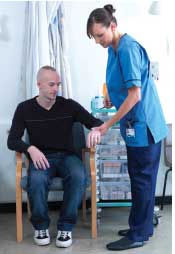 Aggression and Violence
Aggression and Violence
3.3.3. Aggression and violence related incidents account for the highest percentage of recorded staff related incidents within the majority of NHS Boards in Scotland. A number of years ago, in an attempt to address this growing trend, the Scottish Government launched a "zero tolerance approach" to dealing with such incidents. This included the consideration of withdrawing clinical care for repeat offenders and the pursuit of offenders through the criminal justice system. However, incidents of aggression and violence still continue to be the major cause of recorded staff related incidents.
3.3.4. The Emergency Workers (Scotland) Act 2005 provides protection for emergency workers who have to respond to emergency circumstances in the course of their employment. In April 2008, the Act was extended providing doctors, nurses and midwives with protection from obstruction or hindrance whenever they are on duty.
Staff Story Client A charge nurse from a medical admission ward had arrived for an early shift to find the night staff in tears. Some staff were refusing to come in to work that night and some were threatening to call the police. It transpired that the staff had been verbally and physically assaulted during the night shift. The staff were dealing with a gentleman admitted that day. The man had been pleasant and compliant throughout the day, however, he had been incontinent during the night on several occasions and each time the staff attended to him, they were being sworn at, threatened, punched and scratched. The staff had never experience this level of aggression before, but were concerned about leaving the gentleman in a wet bed. Assessment and services provided A violence and aggression advisor visited the ward that morning to assess the situation and offer advice and consultancy. On assessment, the violence and aggression advisor found that the gentleman was only aggressive during the night and when staff were changing him. The violence and aggression advisor suggested alternative approaches which reduced the need to change bedding during the night. Outcomes The staff were able to leave the gentleman to sleep during the night. Staff felt relieved that the solution was not physical restraint and were happy with the focus on addressing the underlying cause of the aggression rather than the aggression itself. Staff were encouraged to attend management of violence and aggression training to increase their confidence and competence in managing difficult situations. The charge nurse called staff together to reflect on the incident, to discuss concerns and to identify learning points for the future. |
3.3.5. Aggression and violence towards staff remains a significant issue, and NHSScotland Boards must therefore give priority to addressing this, both to reduce incidents and to help staff in dealing with such incidents and their consequences.
Slips, Trips and Falls 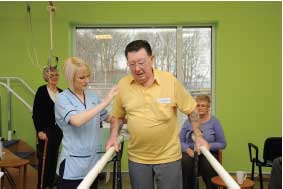
3.3.6. The second highest percentage of recorded staff related incidents within the majority of NHSScotland Boards is termed as slips, trips and falls. These may be caused by staff falling due to slippery floor surfaces or as a result of attempting to catch an unstable patient while providing assistance to them. The HSE has recently targeted a number of Boards with the intention of ensuring that "Slips Strategy Documents" such as policies and procedures are in place to assess the adequacy and suitability of flooring and cleaning regimes.
3.3.7. Tackling these challenges will ensure a safer working environment for all employees, and will also free up resources that would otherwise be spent treating the consequences of these incidents. All employees have a responsibility for their own safety, including seeking to avoid such incidents, where possible. In addition, it is widely recognised that expertise exists within the workforce that can be used to help create a safer working environment. A bottom up approach building on existing partnership working arrangements and employee engagement activities should be encouraged.
Staff Story Client When an NHSScotland Board moved into new accommodation there were a number of slip incidents at the entrance to the building due to the polished marble flooring which became slippery when wet. It was clear that visitors and staff were equally vulnerable and that the costs (actual and potential) associated with slipping accidents were very high. A single slipping incident could cost the Board £15,000 or more. Assessment and services provided Following an assessment, a decision was made on three interim actions. These were designed to do three important things:
Supplementary matting was provided to be laid out in wet weather to provide a large, continuous shoe-drying surface. Permanent reception staff were already on duty at the main building entrance. They were instructed to ensure that the supplementary mats remained in position, did not fold so as to cause tripping and to continually check to see if water was being walked in beyond the mats. Cleaning staff were told to respond immediately to a call from reception to replace any wet supplementary matting and to dry mop any walked in water. In particularly bad weather or periods when there was a lot of pedestrian traffic a cleaner would be on standby duty at the entrance to deal with floor contamination. Umbrella stands were provided at the building entrance door so that rain water from umbrellas did not drip onto the floor. Outcomes The interim changes were not seen as a long-term solution but were adopted as sensible responses pending a more permanent floor surface and building entrance systems review. The number of reported slips incidents was reduced significantly within the interim period with staff appreciating that their ongoing safety was being recognised and catered for. |
3.3.8. In taking forward all four of the priority areas, NHSScotland Boards need to consider how the broader Health Works activity can benefit their own workforce. Health Works focuses on ensuring NHSScotland services improve access and care pathways for people in the general population whose health is affecting their capacity to work. The principles and practice of Health Works apply equally to serving the NHS workforce, and will enable staff to access and benefit from services predominantly provided to patients.
3.3.9. Exercise can play an important role in promoting positive health and wellbeing amongst staff. A total of 30 minutes of moderate intensity exercise, five days a week, will not only help reduce the risk of heart disease, cancer and diabetes, but will also reduce stress levels. The Green Exercise Partnership, in a project inspired by A games legacy for Scotland called NHS Greenspace, has offered support to those NHSScotland Boards which want to develop the NHS estate to promote better health for patients, visitors, staff and the wider community.
3.3.10. The efficiency of NHSScotland should also be improved further to ensure the benefits of a unified health service are more fully realised - for example, through proactively sharing good practice across NHSScotland, and Boards more proactively learning from each other to deliver excellent services and care. This should be supported through the utilisation of national and local partnership arrangements, as well as more effective use of the Staff Governance website. Wider partnerships with other agencies should also be considered, including sharing delivery of services, where appropriate.
3.3.11. The NHSScotland ambition is to be an exemplar employer in relation to the provision of occupational health and safety; to be a centre of excellence and to work with public sector partners to share good practice, learn from experience, and, ultimately, to ensure excellent occupational health and safety provision across Scotland.
Summary and actions:
- NHSScotland Boards must give priority to addressing aggression and violence towards staff, both to reduce incidents and to help staff in dealing with such incidents and their consequences.
- All employees have a responsibility for their own safety, and to seek to avoid slips, trips and falls, where possible.
- A bottom up approach to developing activity to reduce slips, trips and falls is advantageous and should be encouraged, building on existing partnership working arrangements and employee engagement activities.
- The efficiency of NHSScotland should be improved further to ensure the benefits of a unified health service are more fully realised - for example, through proactively sharing good practice across NHSScotland, and Boards more proactively learning from each other to deliver excellent services and care.
There is a problem
Thanks for your feedback
